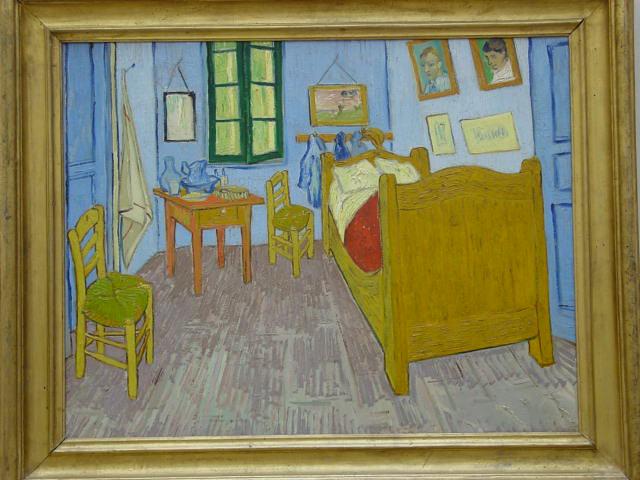Vincent van Gogh's "Starry Night" stands as a testament to the artist's emotional depth and technical prowess. Painted during his time at an asylum, this work captures a blend of personal turmoil and cosmic wonder. Through its swirling skies and vibrant colors, the painting invites viewers to ponder the intersection of art, science, and human experience.
Historical Context and Creation
Vincent van Gogh painted "Starry Night" while staying at Saint-Rémy-de-Provence's asylum. His condition was fragile, and he painted from memory rather than direct observation. The asylum became both his confinement and his inspiration, with limited views of the outside world fueling his imagination.
Van Gogh's letters to his brother Theo reveal his state of mind during this time. He mentioned creating the scene from memory, infusing it with a whirlwind of emotions. His love for astronomy likely influenced the painting, as he regularly read "L'Astronomie," a magazine edited by his friend.
His impasto technique, using thick layers of paint, intensified the swirling elements. These brushstrokes weren't just artistic choices; they reflected the turbulence in his own mind. The color choices were deliberate too, with rich blues and vibrant yellows dominating the night sky. These colors weren't blended but juxtaposed, creating a vibrant, almost buzzing effect.
The bright "star" near the cypress tree is likely Venus. The cypress, often associated with death, reaches into the sky, bridging the earthly village and restless heavens. The village itself is a creation from van Gogh's mind, possibly representing an idealized version of peace and normalcy.
"The starry night is more alive and more brightly colored than the day." – Vincent van Gogh
In his isolation, the night sky became a canvas for van Gogh's dreams and fears. "Starry Night" thus emerges as a masterful blend of scientific curiosity and emotional expression, capturing van Gogh's deepest fears and wildest dreams in paint.

Artistic Techniques and Style
Van Gogh's signature swirling brushwork in "Starry Night" creates a vivid sense of motion that pulls the viewer across the canvas. The impasto technique, layering paint thickly, gives the painting a three-dimensional quality that captures and bends light in a unique way.
His color choices evoke strong emotions. Deep blues contrast with vibrant yellows and oranges, creating a sense of conflict and duality. By avoiding blending and laying down colors in stark contrast, van Gogh created a vibrating, pulsating effect. The close juxtaposition of complementary colors adds an electric feel to the painting.
The directional brushwork serves a purpose beyond aesthetics. Each swirling motion guides the viewer's eye, drawing them deeper into the painting. The sky moves not against the viewer but with them, creating a shared experience of both wonder and unease.
The cypress tree plays a pivotal role, its dark form standing tall against the vivid chaos of the sky. It's like a sentinel, bridging the earthly and the celestial, grounding the entire composition.
Key Techniques in "Starry Night":
- Impasto: Thick application of paint for texture and depth
- Complementary Colors: Use of opposing colors for visual impact
- Directional Brushwork: Guiding the viewer's eye across the canvas
- Light Gradation: Creating the illusion of radiance in celestial bodies
Van Gogh's portrayal of light is masterful. The stars and moon are rendered with vivid yellows and oranges against the cool blues, with centers that are almost incandescent. This purposeful use of color gradation gives the illusion of radiance, making the sky come alive with shimmering light.
In "Starry Night," every brushstroke and dab of color is intentional. It's a collision of technique and emotion, inviting us to see the night as van Gogh saw it, filled with beauty, turbulence, and wonder.

Symbolism and Interpretation
The swirling sky in "Starry Night" captures the viewer's attention immediately. These spirals suggest both the grandeur and chaos of the universe—and in turn, the turmoil within van Gogh himself. It's as if he saw the night sky as a mirror of his own mental state, full of uncontrollable yet beautiful chaos.
The cypress tree, towering and almost menacing, cuts through the sky with its dark form. Cypresses are often associated with death and mourning in many cultures. Here, it stands as a somber sentinel, connecting the grounded village to the restless sky above. It could symbolize van Gogh's struggles with mortality and his yearning for transcendence.
The village, nestled quietly at the foot of this cosmic drama, offers a semblance of peace amidst the chaos. It's almost as if van Gogh is offering a counterpoint to the madness above, showing that even in the midst of inner turmoil, there can be pockets of tranquility. The church's spire, piercing into the heavens, suggests a quest for spiritual solace.
Symbolic Elements in "Starry Night":
- Swirling Sky: Inner turmoil, cosmic chaos
- Cypress Tree: Mortality, connection between earth and heaven
- Village: Peace, normalcy
- Church Spire: Spiritual aspiration
Van Gogh's philosophical leanings are subtly interwoven into the painting. The vastness of the sky evokes a sense of wonder about our place in the universe. The cypress might serve as a reminder of mortality, but juxtaposed against the sky's expanse, it questions what lies beyond this mortal coil.
The painting's color palette—blues ranging from deep indigo to periwinkle, punctuated by explosive yellows and whites—highlights the duality of despair and hope, life and death, the earthly and the cosmic. The use of impasto makes these elements almost tangible.
In "Starry Night," van Gogh marries the cosmic and the earthly, the real and the imagined. Through its symbols, it explores themes of turmoil, peace, mortality, and the search for meaning, inviting viewers to ponder their own place in the universe.
Scientific and Mathematical Analysis
The allure of Vincent van Gogh's "Starry Night" extends beyond art history and emotional symbolism; it also connects with scientific and mathematical fields. When examining the swirling patterns, we uncover a phenomenon resembling turbulent flows observed in nature, specifically in molecular clouds where stars are born.
Physicist José Luis Aragon's studies revealed that the swirling brushstrokes could be compared to mathematical models of turbulence1. Using digital analysis, researchers applied techniques similar to those used in turbulence simulations. By creating two-dimensional maps and employing Fourier analysis, they calculated the power spectrum of "Starry Night." These studies demonstrated that the statistical properties of the brightness fluctuations in the painting resembled those observed in natural turbulent flows.
The comparison between "Starry Night" and images captured by the Hubble Telescope is noteworthy. The telescope once photographed an expanding halo of light around the star V838 Monocerotis, highlighting the universal patterns of turbulence and fluid dynamics that van Gogh intuitively captured.
The influence of astronomy on van Gogh's work is evident, inspired by his regular reading of Camille Flammarion's "L'Astronomie." Van Gogh's depiction of the night sky isn't merely a creative whim but an informed interpretation of celestial phenomena. The crescent moon and potential representation of Venus in the painting point to a thoughtful observation of the night sky.
Scientists like Beattie and Kriel have continued to push these boundaries further by integrating simulated turbulence data into "Starry Night," asking what the painting would look like with the actual patterns of molecular clouds2. This blend of art and science underscores the painting's multi-dimensional complexity and affirms that artistic intuition and scientific observation can be complementary.
Van Gogh's "Starry Night," then, is more than a masterpiece of post-impressionist art; it intriguingly aligns with scientific phenomena, opening a dialogue between the swirling chaos of paint and the equally dynamic turbulence of the cosmos.
Cultural Impact and Legacy
"Starry Night" has had a remarkable cultural impact, influencing not just fine art but permeating popular culture. It remains an unforgettable symbol of both artistic genius and the depths of human emotion.
In modern art, "Starry Night" holds a revered position, inspiring countless artists across various mediums. Van Gogh's innovative use of swirling lines and vibrant color contrasts have set a standard for future generations. Artists often cite Van Gogh's work as a crucial influence in their creative journeys.
The painting has firmly embedded itself within the wider cultural consciousness, appearing in:
- Fashion
- Film
- Literature
- Digital media
Its presence in popular culture is almost ubiquitous; it's a motif that has been adapted by designers, directors, and influencers alike.
From a historical perspective, "Starry Night" has solidified Vincent van Gogh's reputation as one of the most influential artists of all time. Its position in the prestigious MoMA (Museum of Modern Art) in New York since 1941 underscores its importance in art history.
The painting transcends mere visual appeal; it stands as a cultural icon that provokes introspection about the human condition. People from widely varying backgrounds find personal connections to the painting, interpreting its turbulent skies as reflections of their own emotions.
"Starry Night's" presence in educational curricula around the globe emphasizes its cultural significance. Aspiring artists study its techniques, scientists analyze its celestial accuracy, and psychologists explore its emotional complexity. In classrooms, it serves as a gateway into discussions about art, mental health, and the power of individual perspective.
The cultural footprint of "Starry Night" is also marked by its role in public discourse around mental health. Van Gogh's life, marked by struggles with mental illness, mirrors the turbulent beauty of his masterpiece, prompting ongoing conversations about the intersection of creativity and mental health.
In sum, the legacy of "Starry Night" is a mosaic of:
- Artistic brilliance
- Cultural omnipresence
- Emotional resonance
It invites us to see beyond the canvas and into the depths of the human soul, urging us to find beauty in chaos and light in darkness.
In "Starry Night," van Gogh intertwines his inner struggles with the vastness of the universe, creating a piece that resonates on multiple levels. This painting not only reflects his personal battles but also speaks to the universal human condition, making it a timeless piece that continues to inspire and provoke thought.





















